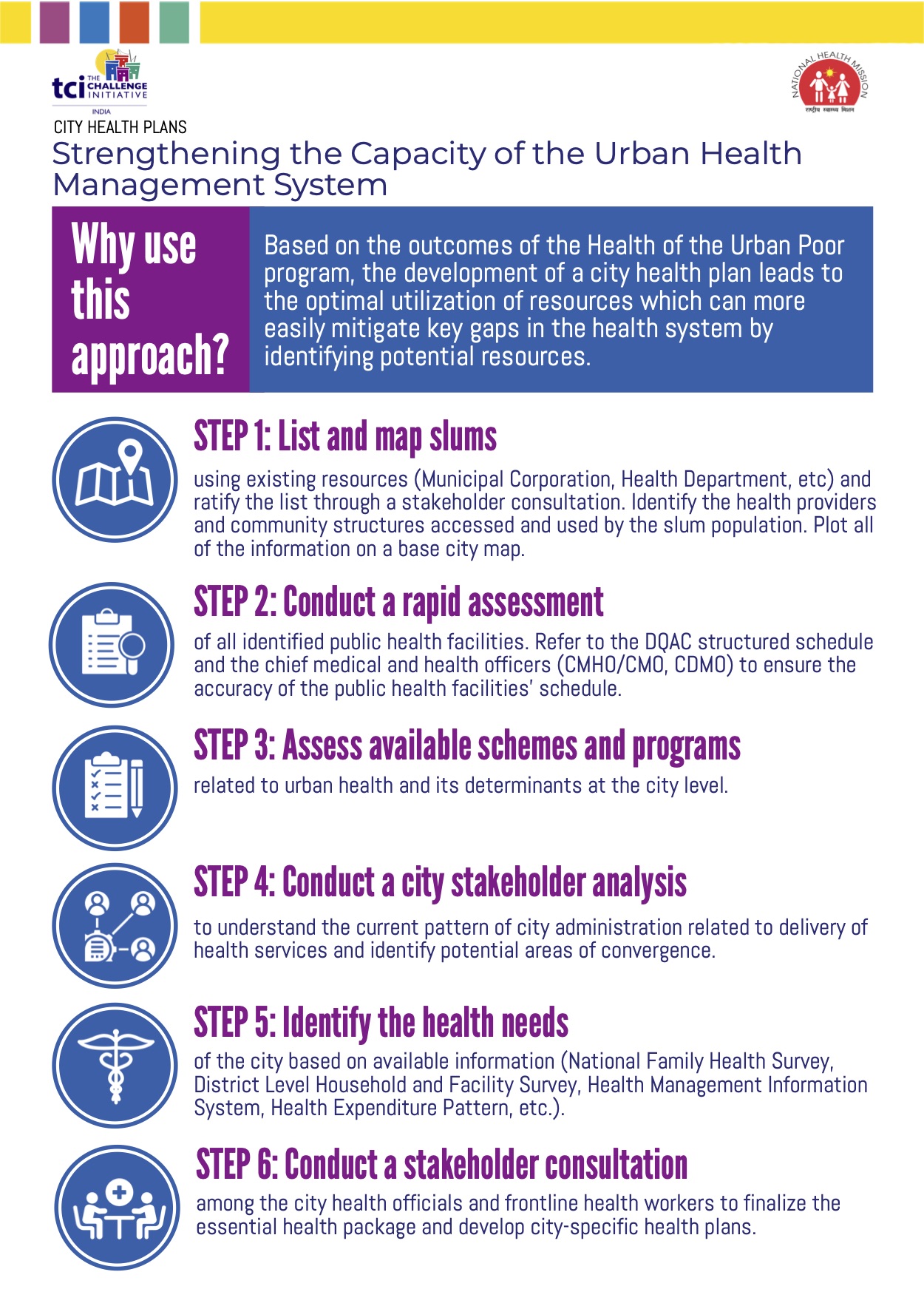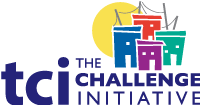India Toolkit: Advocacy
- Home
- Help and Support
- Close
- Toolkits
- Global Toolkit
- AYSRH Toolkit
- Hub Toolkits
- Core High-Impact Practices
- Gender Essentials Mini Course
- Close
- Resource Collection
- Community of Practice
- Coaching
- Log In/Register
- My Profile
- English
City Health Plans
Strengthening the capacity of the urban health management system
 Purpose: To provide a ready reckoner for developing the city-specific health plan with operational guidance for making health services available to the urban poor population by optimal use of available resources.
Purpose: To provide a ready reckoner for developing the city-specific health plan with operational guidance for making health services available to the urban poor population by optimal use of available resources.
Audience:
- Chairman-District Health Society (DHS)
- Chief Medical and Health Officers (CMHO/CDMO/CMO)
- Chairman-Urban Local Body (ULB)
- Nodal Officers Urban Health, District Program Managers (DPM)
- Urban Health Coordinators/City Program Managers
- Representatives from Integrated Child Development Services (ICDS)
- Education, Medical Colleges
- Representatives of relevant Non-Government Organizations (NGO)
- Federation of Obstetrics and Gynaecological Societies of India (FOGSI)/ Indian Medical Association (IMA)
Background: The National Urban Health Mission (NUHM) aims to improve the health status of the urban population in general, but particularly of the poor and other disadvantaged sections, by facilitating equitable access to quality healthcare through a revamped public health system, backed by demand aggregation through community based mechanism with the active involvement of the urban local bodies and engaging with private sectors for filling the gaps at the service provision level.
NUHM envisaged that cities would develop an integrated urban health plan covering the city-specific issues and ensuring that stakeholders from various departments are involved in the planning process. This will also help reprioritize and appropriate resource allocation under National Health Mission (NHM) to NUHM and facilitate a seamless flow between the Program Implementation Plan (PIP) and operational plans. The key to this is comprehensive planning, which will lead to impactful convergence and coordination between all stakeholders such as ICDS, ULB, National Urban Livelihood Mission (NULM)/ District Urban Development Agency (DUDA), Education etc.
However, the absence of comprehensive city specific health plan has caused a delay in reaching out to the desired urban population as envisaged under NUHM. This has resulted in low demand and underutilization of resources for an underserved population. It also contributed to the very poor participation of the private sector, which despite having a significant presence doesn’t supplement the efforts of the public health care delivery system.
Evidence of Effectiveness
The city health plan exercise led to the optimal utilization of resources in Health of the Urban Poor (HUP) program. For e.g. in Lucknow and Kanpur as part of the city health plan, a key gap identified was the lack of event space, which often disrupted the routine of health outreach camps. This gap could be easily mitigated as the city health plan identified potential resources also. Thus in this example, for instance, ULBs provided their space for outreach camps as well as for running Urban Primary Health Centres (UPHCs).
At the time of Urban Health Initiative (UHI) and HUP, city health plans were initiated for 131 cities (refer city health plan Aligarh). Based on these plans, a comprehensive state plan was developed for NUHM for approval from the Government of India (GoI). The approval was received at the juncture of program closures. But, the state itself implemented activities identified in the city health plan, for e.g. infrastructure establishment [UPHCs, Urban Community Health Centre (UCHCs)] for service delivery.
Guidance on Preparing a Comprehensive City Health Plan
A city health plan is an integral part of the NUHM framework, which is a comprehensive approach to urban health planning that optimizes resources and reaches out to the urban poor. This requires an understanding of the distribution of population, health indicators, health services, water supply, sanitation, waste disposal system, migration (in & out) and other city-specific issues. In order to do the same, the following pathway can be taken:
Listing and Mapping
- Identify listed and unlisted slums using existing resources such as Municipal Corporation, Health department, ICDS, National Polio Surveillance Program, UNICEF etc.
- Ratify and update the slum list identified above through stakeholder consultation.
- Identify the health providers accessed by the slum population (this can include public, private health facilities) Identify the list of community structures such as Anganwadi Center (AWC) available under DUDA, NULM and ICDS in the city.
- Plot or superimpose all of the above on the available base city map obtained from potential sources such as Municipal Corporation, National Urban Renewal Mission (NURM), Rajiv Awas Yojana (RAY), NUHM etc.
Rapid Assessment
Conduct rapid assessment of all identified public health facilities (DQAC structured schedule may be referred and CMHO/CMO/CDMO has to ensure the submission of filled in information schedule of public health facilities).
Assessing Available Schemes & Programs
Assess all available schemes and programs related to urban health and its determinants at the city level.
Stakeholder Analysis
Conduct city stakeholder analysis to understand the current pattern of city administration related to delivery of health services and identify potential areas of convergence.
Identification of Needs
Identify the health needs of the city based on available information (National Family Health Survey (NFHS), District Level Household and Facility Survey (DLHS), Health Management Information System (HMIS), Health Expenditure Pattern etc.)
Stakeholder Consultation
Conduct a stakeholder consultation among the city health officials and frontline health workers to finalize the essential health package, and develop city-specific health plan.
Structuring the City Health Plan
Structure the activity based city health plan within the outline of the existing district NHM PIP budget
Monitoring Progress
The city plan is ready and will give guidance for implementation. It is a reference point for monitoring the progress of the health of the city.
A city health plan takes into account the needs of the most vulnerable population in the city. It matches these needs with the existing resources and lays down a clear action plan with milestones, timelines and accountability assigned to various stakeholders involved.
The city coordination committee, convened by the CMHO/CMO/CDMO and constituted by all stakeholders, oversees the implementation and monitoring of the progress of the city health plan. The committee should have regular contact with the organizations or individuals leading each strategy to make sure that the activities are implemented as designed and any barriers in the way get swiftly addressed. The progress of the city health plan is reviewed quarterly. Based on this, the committee can improvise the plan for the next quarter.
Roles and Responsibilities towards Development of a Comprehensive City Health Plan
Role |
Responsibility |
| Chairman, District Health Society |
|
| CMHO/CDMO/CMO |
|
| Nodal NUHM/NGO/NGI Partner |
|
| DPM/Urban Health Coordinator |
|
| Health Facility in-Charge |
|
Monitoring Benchmarks for Developing City Health Plan
The Chairman District Health Society (DHS) with assistance from CMHO/CDMO/CMO can regularly monitor the following indicators:
- City Health Plan completed and submitted on time
- Urban city coordination committee formed meetings
- Stakeholder consultation workshops organized
- Draft city health prepared and submitted to DHS for approval
- Approval from DHS and submission to State Health Society
Cost Elements
The following line items in the NUHM PIP can be used for requesting for City Health Planning:
| Cost Elements | FMR Code | Source |
| Planning & Mapping including Baseline/ end line surveys | P.1 | NHM PIP, Part II NUHM |
| Administrative expenses (including Review meetings, workshops, etc.) | P.2.2.3 | NHM PIP, Part II NUHM |
| Maternal Health | A.1 | NHM PIP, Part I RMNCH+A |
| Child Health | A.2 | NHM PIP, Part I RMNCH+A |
| Family Planning | A.3 | NHM PIP, Part I RMNCH+A |
This table is indicative and illustrates the manner in which cost elements are provisioned in a government PIP, thus giving guidance to the audience on where to look for elements related to a particular task, such as developing city health plans.
Sustainability
A city health plan can be a very productive tool as it provides practical guidance on how to make a city health plan and refer it for monitoring the work plan (i.e. is the city health plan working) and thereby assess the PIP consumption rate. Thus, it can lay the foundation and make the implementation smooth and thus sustain its shelf life.
Disclaimer: This document is based on the learnings collated from Urban Health Initiative, Health of the Urban Poor (supported by USAID) and Expanded Access and Quality (EAQ) to broaden method choice in Uttar Pradesh. This document is not prescriptive in nature but provides overall guidance of how this particular aspect was dealt with in these projects for possible adoption and adaptation.
TCI APP USERS PLEASE NOTE
You will only receive CERTIFICATES by email – when earning a score above 80% – and will not be able to view or print a certifcate PDF from the TCI app.
Test Your Knowledge
Earn a Certificate
Quiz Summary
0 of 5 Questions completed
Questions:
Information
You have already completed the quiz before. Hence you can not start it again.
Quiz is loading…
You must sign in or sign up to start the quiz.
You must first complete the following:
Results
Results
0 of 5 Questions answered correctly
Your time:
Time has elapsed
You have reached 0 of 0 point(s), (0)
Earned Point(s): 0 of 0, (0)
0 Essay(s) Pending (Possible Point(s): 0)
Categories
- Not categorized 0%
- 1
- 2
- 3
- 4
- 5
- Current
- Review
- Answered
- Correct
- Incorrect
-
Question 1 of 5
1. Question
A comprehensive, city-specific health plan helps to reprioritize and appropriately allocate resources and involves all stakeholders.
CorrectIncorrect -
Question 2 of 5
2. Question
The responsibilities of a city coordination committee include:
CorrectIncorrect -
Question 3 of 5
3. Question
Monitoring benchmarks for developing a city health plan include:
CorrectIncorrect -
Question 4 of 5
4. Question
How useful did you find the information and/or tools presented on this page? Please write your response in the box below using one of the following phrases: Very useful, Useful, Somewhat useful, Not useful.
Feel free to comment on why you made that choice.
-
This response will be awarded full points automatically, but it can be reviewed and adjusted after submission.
Grading can be reviewed and adjusted.Grading can be reviewed and adjusted. -
-
Question 5 of 5
5. Question
How do you intend to use the information reviewed and/or tools that you accessed?
-
This response will be awarded full points automatically, but it can be reviewed and adjusted after submission.
Grading can be reviewed and adjusted.Grading can be reviewed and adjusted. -
Advocacy Approaches
Government of India Resources
- NUHM PIP preparation Guidelines 2013-14 (page no. 5)
- Report and Recommendations of Technical Resource Group for National Urban Health Mission (section 3.2 & 3.3 page no. 22, section 3.26 page no. 41-43, section 9.1 page no. 122-124, section 9.3 page no. 127 and chapter 3)
- National Urban Health Mission: Orientation Module for Planners, Implementers and Partners (section 3.2 page no. 27-30, section 3.3 page no. 31-34, and page no. 48-52)
- Task Force to Advise the National Rural Health Mission on “Strategies for Urban Health Care” (chapter 4.3.2 to 4.6 page no. 53 to 63)
- 10th Common Review Mission Report (recommendations for NUHM; page no. 27-28)



